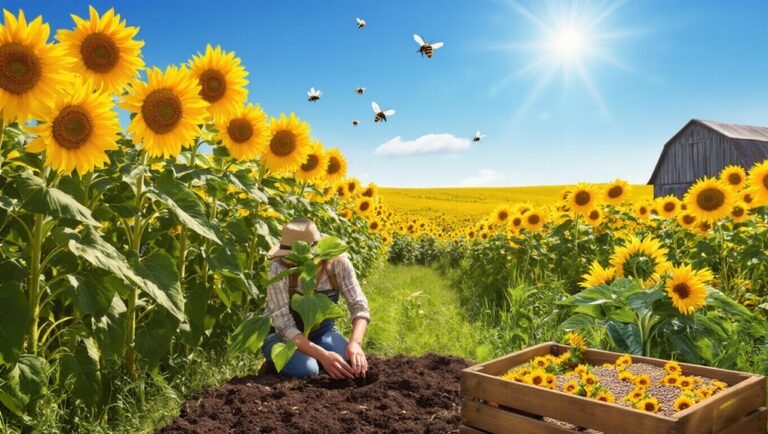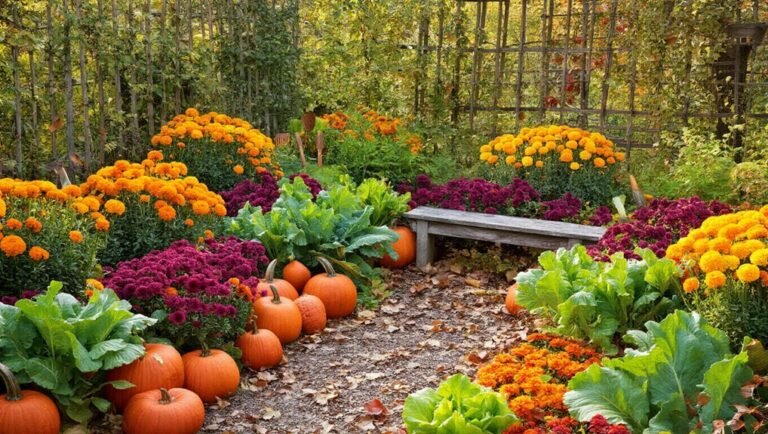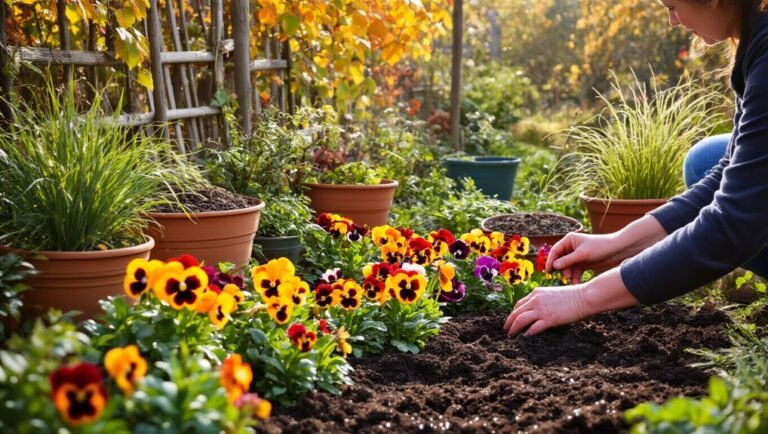The #1 mistake you need to avoid when planting onions is improper timing. If you plant too early, frost can damage your young plants. On the other hand, late planting won’t give bulbs the time they need to develop properly. Aim to plant in early spring, 4-6 weeks before the last frost date, or in fall, 8-10 weeks before the first frost. Get your timing right, and you’ll set yourself up for success in the garden. There’s more to explore about successful onion growing!
Key Takeaways
- Planting onions too late can hinder bulb development; aim for 4-6 weeks before the last frost in spring or 8-10 weeks before the first frost in fall.
- Failing to prepare the soil properly can lead to poor growth; ensure it’s well-draining, loose, and enriched with organic matter.
- Ignoring soil temperature is a mistake; onions thrive best in soil temperatures ranging from 50°F to 85°F.
- Overwatering or underwatering can damage onions; maintain consistent moisture without waterlogging, watering deeply about once a week.
- Neglecting pest and disease management can lead to significant crop loss; monitor for pests and ensure proper air circulation among plants.
Understanding Onion Varieties
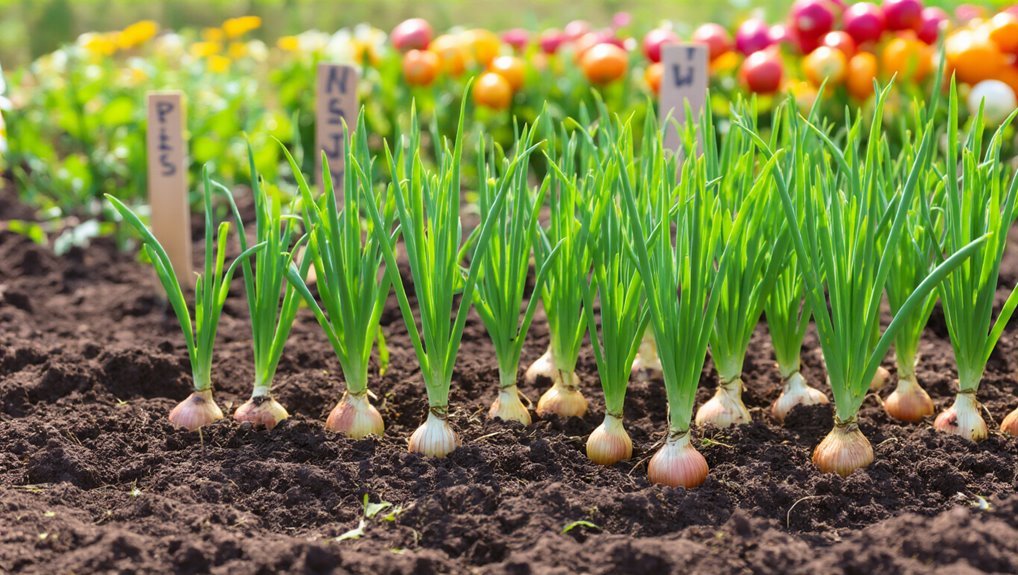
When you start planting onions, understanding the different varieties is crucial, as each type has unique growing conditions and flavor profiles.
You’ll encounter three main categories: yellow, red, and white onions. Yellow onions are versatile, perfect for cooking and have a rich, sweet flavor. Red onions are milder and ideal for salads, while white onions offer a sharper taste, great in salsas. Starting your onions with a herb garden kit can simplify the process and set you up for success, as these kits often include seeds and pots tailored for beginners.
Each variety thrives in specific climates and soil types, so consider your local conditions when choosing. You might also find long-day and short-day varieties, depending on your geographic location.
Selecting the right type will enhance your gardening success and ensure you enjoy delicious onions in your meals. Make informed choices to avoid frustration down the line! If you’re starting seeds indoors, using seed starting kits can greatly improve your onion seedlings’ health and success rate.
Timing Your Planting Correctly
To maximize your onion harvest, timing your planting correctly is essential. Onions thrive in cool weather, so aim to plant them in early spring, about 4-6 weeks before the last frost date in your area.
If you’re planting fall onions, you should do so about 8-10 weeks before your first expected frost.
Keep an eye on soil temperatures, as they should be between 50°F and 85°F for optimal growth. If you plant too early, your onions may suffer from frost damage, while planting too late can hinder bulb development. Adding nutrient-rich compost from a reliable compost bin can further improve your soil and help your onions grow strong and healthy.
Monitor local weather patterns to ensure you’re planting at the right time. With proper timing, you’ll set the stage for a bountiful onion crop.
For the healthiest and most productive onions, make sure you use garden soil that is nutrient-rich and well-draining, as this creates the ideal environment for root and bulb development.
Preparing the Soil Properly
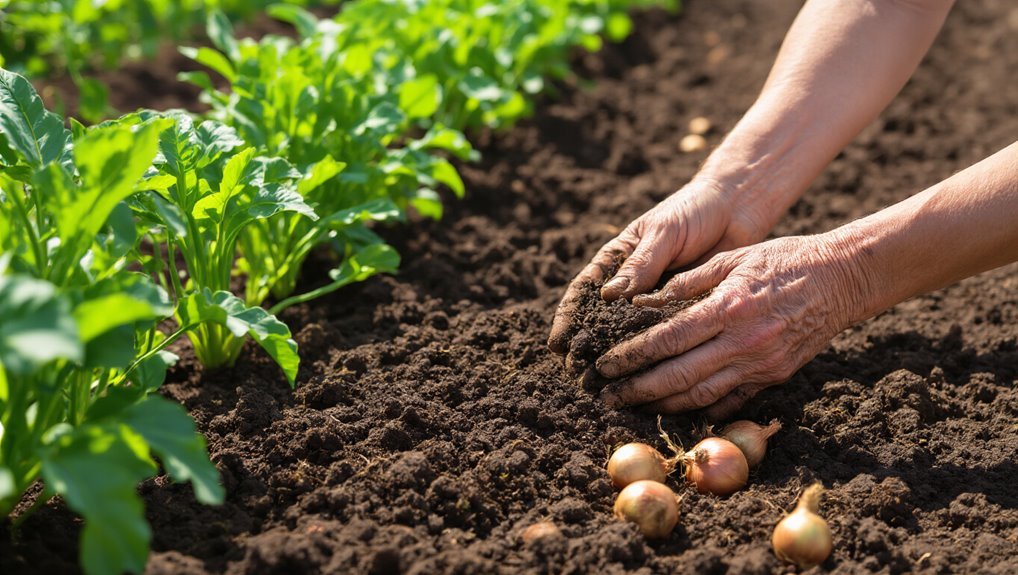
Proper soil preparation is crucial for a successful onion crop. Start by selecting a well-draining location with full sunlight.
Test your soil’s pH; onions thrive in slightly acidic to neutral conditions, ideally between 6.0 and 7.0. Amend your soil with organic matter like compost to boost fertility and structure. This not only improves drainage but also adds essential nutrients. For even better results, you can incorporate organic mulching materials such as straw to help retain soil moisture and enhance soil structure.
Break up any compacted areas and remove rocks or debris that could hinder growth. Ensure your soil is loose and crumbly, which allows onion bulbs to develop properly.
It’s also wise to mix in a balanced fertilizer to provide a nutrient boost right at planting. Taking these steps will set the stage for healthy, vibrant onions in your garden.
For even better soil health and moisture retention, consider using mulch in your garden; it helps suppress weeds and maintains consistent soil temperatures for optimal onion growth.
Watering Techniques for Onions
While establishing a consistent watering routine, it’s essential to keep in mind that onions require adequate moisture without becoming waterlogged.
Aim to water your onions deeply, ensuring the soil is moist to about 6-8 inches below the surface. This encourages strong root development. Water them about once a week, or more frequently during hot, dry spells. Using essential garden hoses can make it easier to reach all parts of your onion bed, ensuring even moisture throughout.
Be sure to check the soil moisture before watering; if the top inch feels dry, it’s time to give them a drink. Use a drip irrigation system or soaker hoses to deliver water directly to the roots, minimizing evaporation.
Avoid overhead watering, as wet foliage can promote disease. With proper techniques, you’ll help your onions thrive and achieve a bountiful harvest.
To maximize your garden’s potential, consider installing drip irrigation systems that provide consistent moisture while reducing water waste and the risk of disease.
Managing Pests and Diseases
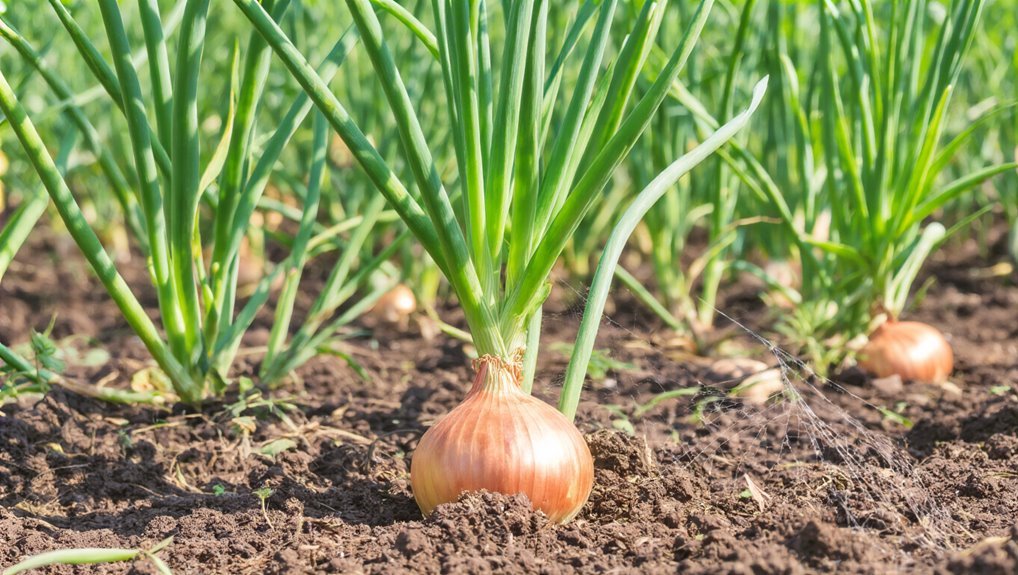
Effective watering not only supports growth but also helps prevent certain pests and diseases that can plague your onion crop.
To manage pests, keep a close eye on your plants for signs of trouble, like wilting or discoloration. Use row covers to protect young onions from insects, and consider natural predators like ladybugs for aphid control.
For diseases, practice crop rotation and avoid planting onions in the same spot year after year. Ensure proper air circulation by spacing your plants adequately and removing any debris that could harbor pathogens.
Regularly inspect your onions and act quickly if you spot any issues. By staying vigilant and proactive, you can enjoy a healthy and bountiful onion harvest.
Frequently Asked Questions
Can Onions Be Grown in Containers?
Yes, you can grow onions in containers! Choose a deep pot with good drainage, use quality potting soil, and ensure they receive plenty of sunlight. Water them regularly, and you’ll enjoy fresh onions in no time!
What’s the Best Way to Store Harvested Onions?
Storing harvested onions is like preserving gold in your pantry! To keep them fresh, place them in a cool, dark, well-ventilated area. Avoid moisture, and they’ll last for months, ready for your delicious dishes!
How Long Do Onions Take to Mature?
Onions typically take about 90 to 120 days to mature, depending on the variety. You’ll want to keep an eye on their size and the foliage’s health as they approach harvest time. Happy gardening!
Are There Companion Plants for Onions?
While you might think onions don’t need companions, they actually thrive alongside carrots, beets, and lettuce. These plants can help deter pests, promote growth, and ultimately enhance your onion harvest’s flavor and yield.
Can I Grow Onions From Kitchen Scraps?
Yes, you can grow onions from kitchen scraps! Just place the root end of an onion in water or soil, and watch it sprout. It’s a fun and sustainable way to expand your garden!
Conclusion
In the grand tapestry of gardening, avoiding the #1 mistake with onions can make all the difference. By choosing the right variety, timing your planting, prepping your soil, and mastering watering techniques, you’ll cultivate a bountiful harvest. Think of your onions as jewels in the crown of your garden; with the right care, they’ll shine bright and flavorful. So roll up your sleeves, dig in, and watch your onion patch flourish like a masterpiece in bloom!
